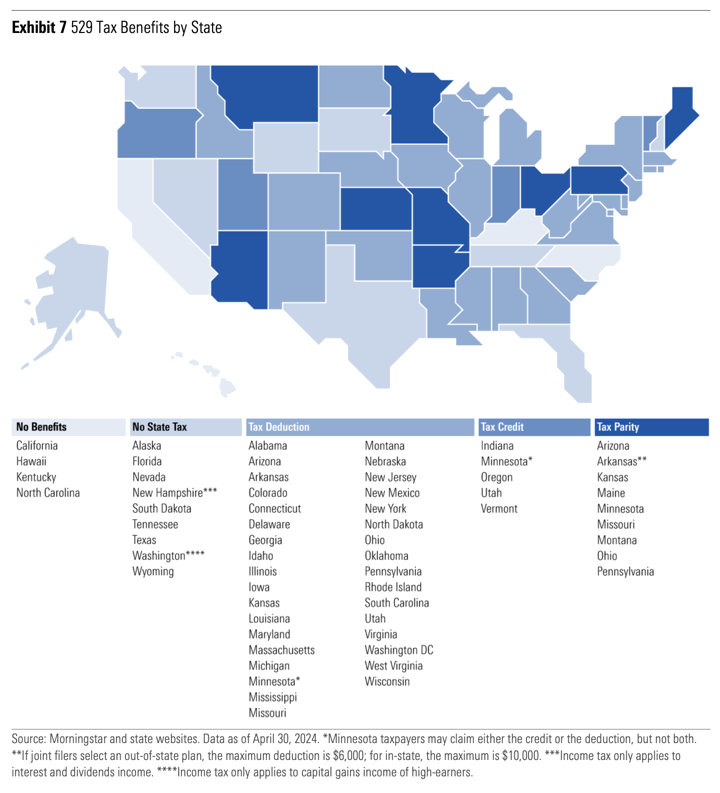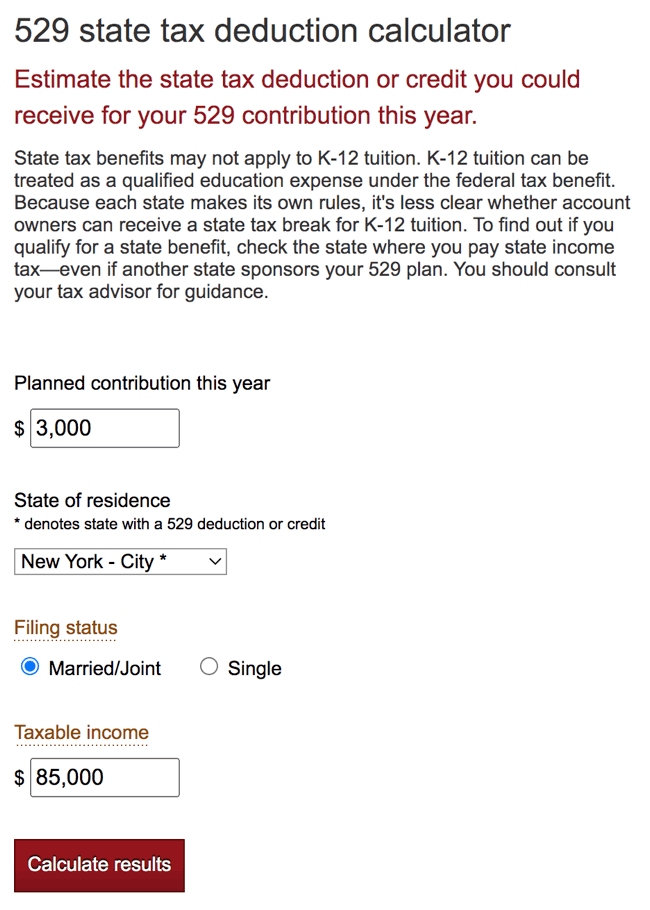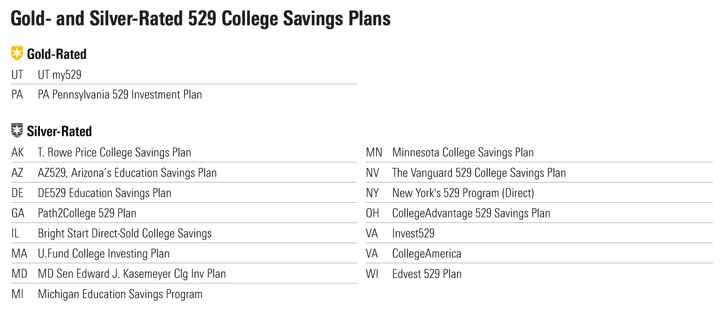
Updated for 2024. Morningstar is a great resource for research on 529 college savings plans, and they have recently updated their annual deep dive on 529 plans: The 2024 529 Savings Plan Landscape (e-mail required).
When choosing a 529 college savings plan, you can open a 529 plan from any state (not just your own). However, each state can vary widely in what they offer in terms of tax deductions and/or tax credits. So how to do you choose?
- No state tax? ➡ Just pick the best overall plan.
- No special tax benefits (deduction or credit)? ➡ Just pick the best overall plan.
- Home state offers tax parity? (the same tax benefits no matter which state’s plan you pick) ➡ Just pick the best overall plan.
- Home state requires you to contribute to your home state plan to get the tax perk? ➡ Technically, you should compare the annual tax savings against any potential perks from the best overall plan (lower annual expenses, superior investment options). In most cases, I have found that if a state cares enough to offers a state tax deduction or tax credit, and you are contributing an amount under or around the max limit (ex. under $200 a month), then the in-state plan is most likely good enough and you should stick with it. The main exception is if you plan on funding your plan with a large upfront contribution, where a lower expense ratio would really matter.
If you are in the last situation in which you have to do some math, this Morningstar article also runs the numbers for a theoretical couple filing jointly with a gross annual income of $100,000 that deposits $3,000 a year (or $250 a month) into one beneficiary’s 529 account. The chart is useful to provide a quick idea of your state’s tax benefits at a glance, but I would make sure to run the numbers for your income and your expected annual contribution. This Vanguard state deduction calculator tool may be helpful to double-check your calculations.

Finally, note that some states will also recapture any tax benefits if you perform an outbound 529 rollover, or otherwise do not conform with federal tax laws regarding 529 distributions.
Top plans quick recap. Here are Morningstar’s top Gold and Silver-rated plans as of Summer 2024.

I personally invest in the Utah My529 Plan for my children due to their DIY glide path feature and DFA fund access, but my second choice would be the Vanguard Nevada 529 Plan if you want something that is more “set-and-forget”, especially if you already have other accounts at Vanguard. I wouldn’t spend too much time splitting hairs – taking action and starting an automatic savings plan is the most critical decision.
Opening a plan and making any contribution also starts the 10-year clock on potential future 529-to-Roth IRA rollovers.
 The Best Credit Card Bonus Offers – 2025
The Best Credit Card Bonus Offers – 2025 Big List of Free Stocks from Brokerage Apps
Big List of Free Stocks from Brokerage Apps Best Interest Rates on Cash - 2025
Best Interest Rates on Cash - 2025 Free Credit Scores x 3 + Free Credit Monitoring
Free Credit Scores x 3 + Free Credit Monitoring Best No Fee 0% APR Balance Transfer Offers
Best No Fee 0% APR Balance Transfer Offers Little-Known Cellular Data Plans That Can Save Big Money
Little-Known Cellular Data Plans That Can Save Big Money How To Haggle Your Cable or Direct TV Bill
How To Haggle Your Cable or Direct TV Bill Big List of Free Consumer Data Reports (Credit, Rent, Work)
Big List of Free Consumer Data Reports (Credit, Rent, Work)
We live in the state of Maryland. As a married couple we are actually each allowed to deduct $2500 worth of contributions to 529 accounts for each of our dependents. For example, we have two children and I have set up a total of four 529 plans, two in my name (each with one of the children as beneficiary) and two in my wife’s name (each with one of the children as beneficiary). Doing that allows each of us to deduct up to $2500 per beneficiary since we file jointly, for a total possible deduction of $10k per year for our two children. This is pretty common practice in my state.
Also, if you contribute in excess of the $2500 to an account for your beneficiary in a given year, you can carry forward those undeducted contributions for up to 10 years. They recommend you keep very good records to do this, but I could foreseeably still be deducting contributions when my children are in their early 30s, 10 years after my last contribution to their plan, which significantly increases the total amount you can deduct over a lifetime. There are also total lifetime contributions limits per student (all accounts combined) of $350k, and I believe that means once the sum of their accounts reach that value you can no longer contribute.
Other states may have similar ways to capture more tax benefits that folks in those states know about but aren’t clear on a chart like this that just codifies the basic parameters of the deductions.
Keep in mind this chart is not about the *max* tax benefits available, it is about comparing the relative tax benefits for a hypothetical couple with limited money ($100 a month each to 2 kids) to contribute.
We live in Washington state and while the state does not offer a 529 Savings Plan it does operate a unit-type prepaid tuition program, which seems to be the better way to go. Each unit purchased through the prepaid tuition program is redeemable for one percent of the resident undergraduate tuition at the highest-priced public university in Washington (University of Washington or Washington State University), and may be used for any eligible educational institution in the country, or even other countries. I think it is amazing that we can fund part or all of our child’s college education eighteen years from now using today’s dollars.
Well, there is a built-in adjustment for tuition growth so you aren’t really paying today’s tuition rates for a degree 18 years from now, but yes there are prepaid plans from various states that can be good options if you want low risk. Florida Prepaid recently actually decreased their prices.
Right, the current cost of 1 unit of tuition for the WA plan is $172. That will get you $117 worth of tuition right now so you’re paying a premium to account for future tuition growth. Thats the WA plan, but other state guaranteed tuition plans vary in their structure and how the costs work. Like you said FL slashed their rates and is now a pretty good deal.
I was going to point out that technically Washingtons prepaid tuition plan IS a 529 plan. Even says so right on the states website. Prepaid tuition plans are 529’s officially under the law, they just work differently than most 529’s.
MD also has a pre-paid option whereby you can purchase a semester of tuition at an inflated version of today’s rate where the price is determined by your child’s age. Then those dollars grow at the rate of the average public tuition rate until you need them. I considered buying some semesters and using that as the fixed income portion of my total asset allocation, i.e. combining that with a 100% (or slightly lower) equity allocation in the 529 investment plan. I would do this because it is possible that the “return” from the prepaid will be better than my expected return from a bond fund over the next 15-20 years. I haven’t done this yet but I ran some numbers last year and it seemed to be a viable way to go.
Has anyone considered or done this?
Maryland’s 23 counties and Baltimore City levy a local income tax which is collected on top of the state income tax. Local officials set the rates, which range between 1.25% and 3.20% for the current tax year.
For some reason, any national tax comparison always fails to mention this additional tax – making Maryland income tax seem less than it really is. In my case it’s a total of 7.75%, making a 529 even more beneficial.
Amen brother, don’t I know it! Mine is 8.58%!
Yikes.
I think this is an important paragraph in the article that should be included in your post to further clarify the $0’s on the above chart.
“Seven states do not charge income tax (Alaska, Florida, Nevada, New Hampshire, South Dakota, Tennessee, and Texas), and eight do not allow an income tax deduction of any kind (California, Delaware, Hawaii, Kentucky, Massachusetts, Minnesota, New Jersey, and North Carolina), eliminating state-level benefits from consideration. In these cases, college savers can go with an out-of-state 529 plan without giving up any local tax perks.”
“In these cases, college savers can go with an out-of-state 529 plan without giving up any local tax perks.”
I am not sure what this means. “Local” means what here? Thanks.
Meaning that because they have no state tax benefits to lose in the first place, they won’t be giving anything up by using an out of state plan. The way it is worded is a little ambiguous.
Thanks.
But no taking advantage of another state’s beneifts becuase you live within a state that offers no benefits, right. For me – I am in Minnesota – that means I can look at all state plans as well as something like Vanguard 529 plans as options on equal footing.
I believe they meant to say “state tax perks” instead of “local tax perks”. I also believe the point they are making is that state tax perks may offset the deficiencies in your state’s 529 plan and make it more attractive. However, you and I have similar situations, because I am in California and you are in Minnesota, there is no state tax benefit to using our home state’s 529 plan, so we are most likely better off looking elsewhere. Having a mediocre state plan and at the same time giving no tax breaks for using it is just the worst combination.
Hi Jonathan, thanks for putting this table together. I’m in Pennsylvania and I’m wondering about the calculation for “Dollar Value of Tax Benefit” column. I would have expected to multiply the Deduction Contribution Limit by the State Marginal Tax but that just doesn’t add up. What am I missing?
Also – can you explain the Tax Parity column?
Thanks for your response.
Scarlo, tax parity means that you get the tax break regardless of which state’s plan you choose. I also live in PA, and because of the opportunity provided to choose any state’s plan, I chose Utah’s. I found the expenses for PA’s plan to be high at the time I researched them all.
I could be a commercial for Utah’s plan. The oldest kid is in college now and the others are younger. Administrative expenses have been LOWERED over the years, and both contributions and withdrawals have been easy to implement.
I think the cost vs tax benefit argument is flawed a bit. Per my understanding, cost hits every year the $s are in invested mode and the tax benefit is one time. For example, if I invest $100 in Arkansas plan, I get $7 tax benefit once, but the high cost of Arkasas plan is charged every year. So my sole criteria would be just annual cost. In my opinion, tax benefits are just a bait to get investors into high cost plans of states one lives in. Most of these state plans (by most, I mean almost all except 4 or 5 plans) costs are so ridiculously priced that any tax benefits will be offset by plan costs in first few years and after that its net loss.
The primary reason anyone should invest in 529k plan is that the qualified withdrawals are tax free, and it applies irrespective of the plan we choose. So, Choose lost cost plans and ignore tax benefits as a criteria. I would have liked Morningstar to call out something like this very clearly. But they would not.
Morningstar does address this; please read the full whitepaper. The upfront benefit effectively decays over time as annual costs eat into it. You have to weight them both. You can’t say your sole criteria is annual cost, as would you give up 5% upfront tax break for 0.01% in annual expenses?
Illinois’ tax rate has gone back to the original 3.75% value. http://www.revenue.state.il.us/TaxRates/Income.htm
Minnesota now offers a tax deduction (or the credit for lower income levels). A $1,500 tax deduction ($3,000 for a married couple filing jointly) can be claimed against Minnesota income tax. Alternatively, a tax credit equal to 50% of the contributions to accounts, reduced by any withdrawals, may be claimed with a maximum credit amount of up to $500, subject to a phase-out schedule starting at a federal adjusted gross income of $75,000.
Why isn’t Massachusetts on this?
Is it just me or is Massachusetts missing from the top chart? And yet there are still 50 states listed…
This stuff’s always so annoyingly unclear. Why does a California plan even exist if, **from what I understand based on the convoluted and seemingly never straight to the point stuff I’ve read**, there’s zero reason to pick a California plan over any other state’s plan? Actually, why do any of them exist other than the one with the most benefit?? Is there some penalty for choosing another state’s plan? If so, that would be the first thing I’d write when talking about 529 plans.
Jonathan so I’m going to use student loans instead of paying for their college in advance. The loans are 0% interest until they graduate at which time wouldn’t you be mad if you paid in advance and a Democrat President/Congress passed a law to forgive all student debt by then? Better to at least plan in case that happens rather then give away a needless $100-$200K up-front only to later find out the trillions in student debt magically go away even partially.
Seems like a fine move if you’re not paying interest anyway, but no interest until graduation is only valid for subsidized loans right? Which are harder to get.
The table is incorrect for Virginia. Virginia taxpayers can deduct up to $4,000 annually per ACCOUNT, not per beneficiary. For a couple with two children who open multiple types of accounts, this can easily increase the deduction to $32,000 per year or more.
Thanks, Scott – To clarify, are you saying that a couple with 2 kids can open 8 different accounts, broken down to 4 with spouse 1 as owner and spouse 1, spouse 2 , kid 1, kid 2, as beneficiaries + another 4 with spouse 2 as owner and the same 4 beneficiaries?
Are there are no tax recapture rules if you change the beneficiaries down the line?
I’ll give a more specific example to explain. We have three different account types/brokers in Virginia (used to be four but they dropped one): https://529s.com/state-plans/virginia-529-plan/. The two straightforward ones are Virginia529 and CollegeAmerica (through American Funds/Capital Group). Both are also rated highly. So each spouse opens a Va529 and a CA account per child. 2 spouses x 2 children x 2 account types = 8 accounts total = up to $32,000 deduction. I’m not an advisor, but I’ve talked to multiple advisors and clients who have confirmed this specific strategy and have done it for many years.
To answer your second question, I’ve never heard of any tax recapture rules. It’s all based on accounts, not beneficiaries. In theory, I understand that you could open multiple accounts at the same broker, e.g. multiple Virginia529 accounts for a single beneficiary, and still do the strategy. I’ve heard of people doing that, but don’t have any personal confirmation that it works. I don’t know of any cap/max to the number of accounts you can have open and for which you can claim a deduction.
Does it seem like a loophole? Yeah. Will the state of Virginia ever close it? Maybe. So far they have shown no inclination to do so. I’m guessing there’s not enough people investing in this way yet for it to make a meaningful difference on their bottom line.
Yes, this is correct. It works with multiple Virgina529 accounts as well, so you don’t have to do CollegeAmerica accounts.
State income tax deductions are nice when available, and low plan fees are also great things to consider. However, the only thing not talked about enough when considering 529 plans are your state’s tax recapture laws.
Some states will tax your out of state 529 qualified withdrawals as ordinary income. Sometimes, you can get around this by doing a rollover, but those are limited as well.
A few websites which do explore this, which have helped me.
https://www.savingforcollege.com/article/what-happens-to-your-529-plan-when-you-move-to-another-state
https://www.savingforcollege.com/article/states-that-do-not-conform-with-federal-529-plan-tax-laws
I moved my 529 from Ohio to Nevada (Vanguard) last year. Today, I updated the 529 information in Upromise, adding the new Nevada 529 and naming a new beneficiary. Unexpectedly, I instantly saw a $25 increase in my Upromise account, with “$25 529 linking bonus” newly listed under “earnings”. I had added Ohio to Upromise two years ago.
Nice!
We use the Utah 529 because of low expenses. We started all 4 Gkids at birth on their 529s.